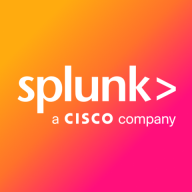

Splunk Enterprise Security and Cortex XSIAM are prominent in the security technology category, each offering unique strengths for organizational needs. Splunk has the upper hand due to extensive customization and superior data visualization capabilities, while Cortex XSIAM stands out for its automation and machine learning-driven threat detection.
Features: Splunk Enterprise Security provides advanced search capabilities, seamless third-party integration, and comprehensive dashboards, offering flexibility across diverse environments. Its risk-based alerting and AI-driven analytics enhance customization and threat intelligence. Cortex XSIAM emphasizes strong machine learning algorithms, advanced automation, and efficient threat detection. It integrates threat intelligence effectively across various platforms, promoting a unified security approach with improved incident response processes.
Room for Improvement: Splunk faces criticism for high costs, complex pricing models, and a steep learning curve, with users desiring more affordable pricing options and enhanced AI functionalities. Cortex XSIAM can improve its user interface intuitiveness and broaden its tool integration scope. Users also note the need for better support responsiveness and simpler licensing terms.
Ease of Deployment and Customer Service: Splunk supports diverse deployment options, including public, private, hybrid clouds, and on-premises, although its setup process is complex. Customer support receives mixed feedback, but community resources are helpful. Cortex XSIAM focuses on public cloud deployments, facilitating easier integration and streamlined processes, yet both products could improve support responsiveness and technical assistance.
Pricing and ROI: Splunk's data ingestion-based pricing can lead to unpredictable and high costs, presenting challenges for smaller organizations despite significant ROI from its robust features. Cortex XSIAM offers competitive, predictable pricing attractive to larger enterprises seeking automation benefits, though it remains costly. Both solutions provide valuable returns through enhanced security measures, with Splunk's pricing structure suiting large-scale operations and Cortex offering a more consistent pricing model.
The documentation for Splunk Enterprise Security is outstanding. It is well-organized and easy to access.
We couldn't calculate what would have been the cost if they had actually gotten compromised; however, they were in the process, so every investment was returned immediately.
On average, my SecOps team takes probably at least a quarter of the time, if not more, to remediate security incidents with Splunk Enterprise Security compared to our previous solution.
With premium support, core Palo Alto technical experts handle issues directly.
It is ineffective in terms of responding to basic queries and addressing future requirements.
The Palo Alto support team is fully responsive and helpful.
We have paid for Splunk support, and we’re not on the free tier hoping for assistance; we are a significant customer and invest a lot in this service.
I have had nothing but good experiences with Splunk support, receiving timely and helpful replies.
We've had great customer success managers who have helped us navigate scaling from 600 gigs to 30 terabytes.
Without proper integration, scaling up with more servers is meaningless.
Cortex XSIAM is highly scalable.
We currently rely on disaster recovery and backup recovery, which takes time to recover, during which you're basically blind, so I'm pushing my leadership team to switch over to a clustering environment for constant availability.
It is one of the things that separates it from other tooling, and if not, it is the most scalable solution out there.
They struggle a bit with pure virtual environments, but in terms of how much they can handle, it is pretty good.
The product was easy to install and set up and worked right.
Overall, Cortex XSIAM is stable.
It works really nice and performs really efficiently after configuration.
They test it very thoroughly before release, and our customers have Splunk running for months without issues.
Splunk has been very reliable and very consistent.
We need more SMEs, and there is no mechanism to tell us about indexer or search head issues.
Obtaining validation for integrations from Palo Alto takes around eight months, which is quite long.
Cortex XSIAM needs improvements in terms of data onboarding, parsers, and third-party integration supports.
Cortex XSIAM is on the expensive side and requires substantial improvement in pricing.
Improving the infrastructure behind Splunk Enterprise Security is vital—enhanced cores, CPUs, and memory should be prioritized to support better processing power.
Splunk Enterprise Security is not something that automatically picks things; you have to set up use cases, update data models, and link the right use cases to the right data models for those detections to happen.
For any future enhancements or features, such as MLTK and SOAR platform integration, we need more visibility, training, and certification for the skilled professionals who are working.
The first impression is that XSIAM would be more expensive than others we tried.
The product is very expensive.
Cortex XSIAM is pretty expensive, and the licensing process is not very comfortable.
I saw clients spend two million dollars a year just feeding data into the Splunk solution.
The platform requires significant financial investment and resources, making it expensive despite its comprehensive features.
I find it to be affordable, which is why every industry uses it.
The advanced visualization capabilities of the product are important for understanding security trends in an organization.
One of the valued aspects of the product is its use of artificial intelligence to detect security vulnerabilities.
The flexibility for creating manual workflows stands out.
This capability is useful for performance monitoring and issue identification.
I assess Splunk Enterprise Security's insider threat detection capabilities for helping to find unknown threats and anomalous user behavior as great.
Splunk Enterprise Security provides the foundation for unified threat detection, investigation, and response, enabling fast identification of critical issues.
| Product | Market Share (%) |
|---|---|
| Splunk Enterprise Security | 8.0% |
| Cortex XSIAM | 2.6% |
| Other | 89.4% |
| Company Size | Count |
|---|---|
| Small Business | 9 |
| Midsize Enterprise | 2 |
| Large Enterprise | 4 |
| Company Size | Count |
|---|---|
| Small Business | 109 |
| Midsize Enterprise | 50 |
| Large Enterprise | 263 |
Cortex XSIAM acts as a critical element for SOC foundations, integrating SIEM and EDR capabilities, valued for threat detection and seamless security orchestration with Palo Alto Networks products.
Organizations find Cortex XSIAM beneficial for SOC foundations due to its capability to integrate SIEM and EDR tools, facilitating data collection, detection, and response. It connects with third-party data sources while reducing management effort and offering cost-effective alternatives to competitors like CrowdStrike and Trend Micro. Featuring automation and integration with Palo Alto Networks products, Cortex XSIAM enhances threat detection. Unified architecture allows a comprehensive view of attacks, further supported by machine learning and integration with existing vendor solutions, ensuring that users gain insights without significant manual log analysis.
What are Cortex XSIAM's key features?
What benefits are evident in Cortex XSIAM reviews?
Industries implement Cortex XSIAM mainly in technology-driven sectors where centralized endpoint protection and automation of forensic investigation are paramount. By integrating several third-party systems for incident response, companies in competitive markets leverage its attributes for heightened operational security efficiency. However, users note areas for improvement, such as Attack Surface Management and integration enhancements, to better suit tech-heavy industries needing extensive connectivity with cybersecurity solutions.
Splunk Enterprise Security delivers powerful log management, rapid searches, and intuitive dashboards, enhancing real-time analytics and security measures. Its advanced machine learning and wide system compatibility streamline threat detection and incident response across diverse IT environments.
Splunk Enterprise Security stands out in security operations with robust features like comprehensive threat intelligence and seamless data integration. Its real-time analytics and customizable queries enable proactive threat analysis and efficient incident response. Integration with multiple third-party feeds allows detailed threat correlation and streamlined data visualization. Users find the intuitive UI and broad compatibility support efficient threat detection while reducing false positives. Despite its strengths, areas such as visualization capabilities and integration processes with cloud environments need enhancement. Users face a high learning curve, and improvements in automation, AI, documentation, and training are desired to maximize its potential.
What Are the Key Features of Splunk Enterprise Security?In specific industries like finance and healthcare, Splunk Enterprise Security is instrumental for log aggregation, SIEM functionalities, and compliance monitoring. Companies leverage its capabilities for proactive threat analysis and response, ensuring comprehensive security monitoring and integration with various tools for heightened operational intelligence.
We monitor all Security Information and Event Management (SIEM) reviews to prevent fraudulent reviews and keep review quality high. We do not post reviews by company employees or direct competitors. We validate each review for authenticity via cross-reference with LinkedIn, and personal follow-up with the reviewer when necessary.